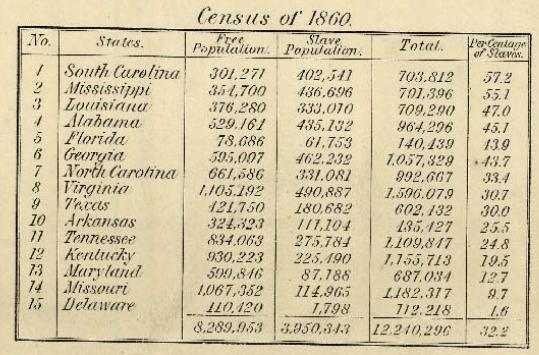@middlebrow
For instance, my family is from Alabama. Both sides. Like MANY AADOS.
Look at our "FPOC" and Free Negro" population.'
Here the 1860 Census numbers:
Free People of Color 1860 Census...
Alabama 2690
Arkansas 144
Florida 932
Georgia 3,500
Louisiana 18,647
Mississippi 773
North Carolina 30,463
South Carolina 9,914
Tennessee 7,300
Texas 355
Virginia 58,042
Kentucky 10,684
Missouri 3,572
Maryland 83,942
Now look at the Slave Census:
So, my family - both sides - from Alabama -- In 1860 had 435K enslaved people -- and 2,690 "FPOC" or Free Negro (two different classifications).
FPOC also enslaved Black people. "Free Negros" usually owned their family members - so they wouldn't be sold away. Big difference.
In terms of FPOC in Alabama -- they were in Mobile - due to the many Creoles there.
"The growing threat from abolitionist propaganda influenced the Alabama legislature to prohibit manumission in 1860. Mobile County had a large population of free blacks, many of whom were mulatto descendants of the Spanish and French. These Creole Negroes were well educated due to special provisions of Mobile law. They were prosperous merchants, barbers, blacksmiths, carpenters, draymen, and coachmen. Many were descendants of Pierre Chastang who carried supplies for Andrew Jackson's troops during the War of 1812 and, when yellow fever spread in Mobile in 1819, cared for the sick and buried the dead. He was freed by popular subscription for these public services. When Chastang died in 1848, the Alabama Planter in Mobile lauded him as a "highly esteemed and respected" member of the community.'" In 1850 Mobile had 41 percent of the state's free blacks.
"Solomon Perteet, who operated a store in 1i.1scaloosa, was another well-known free black. When Sir Charles Lyell visited Tusscaloosa in 1846, he was amazed at Perteet's accumulation of wealth from his real estate transactions.
"James T. Rapier, the son of a free Negro woman and a planter from Huntsville, was sent by his father to Canada and Scotland for his education and later during Reconstruction represented Alabama in Congress.
"Many of Alabama's free blacks owned slaves. Seven Chastang families in Mobile owned twenty-seven slaves in 1850, and two other Mobile free blacks owned thirty slaves.
"Horace King was one of the most famous free blacks in Alabama. A slave of South Carolina bridge contractor John Godwin, King supervised the construction of dozens of bridges in Alabama before and after he was manumitted by his owner with the approval of the Alabama legislature in 1846. While it was known that King worked on the Alabama capitol during construction in 1850-51, his responsibilities were not specified; however, he probably built the curving stairs. Restoration of the building in the late 1980s revealed that the bracing design that undergirded the stairs and connected them to the wall without any visible suppon was exactly the method King used to construct his bridges.


 yall deserve this movement and the awakening that will come from it. Cause I know many Black immigrants would have issues if ADOS came to their countries in the Caribbean and across Africa to run for political offices, run their newspapers/mass media, attend their colleges, etc. So they are being hypocritical. If anybody goes to someone's country they should always be respectful of them and their culture. For years they have failed to do so and you could say for decades also.
yall deserve this movement and the awakening that will come from it. Cause I know many Black immigrants would have issues if ADOS came to their countries in the Caribbean and across Africa to run for political offices, run their newspapers/mass media, attend their colleges, etc. So they are being hypocritical. If anybody goes to someone's country they should always be respectful of them and their culture. For years they have failed to do so and you could say for decades also.